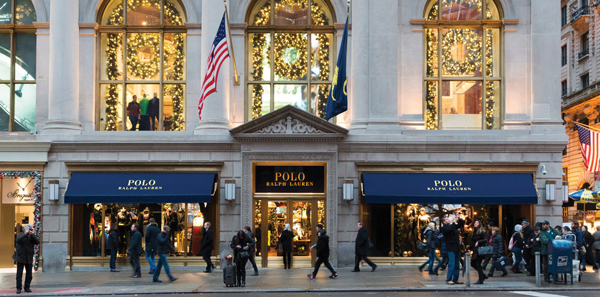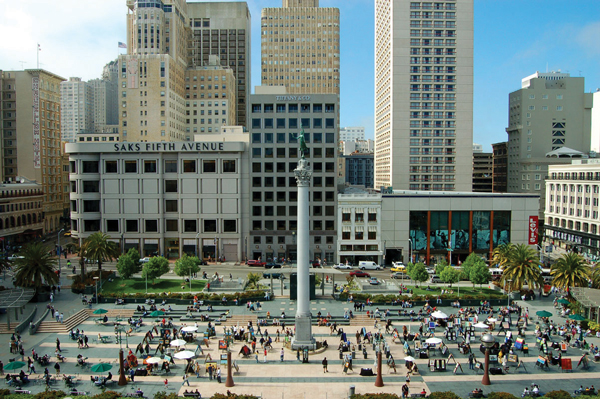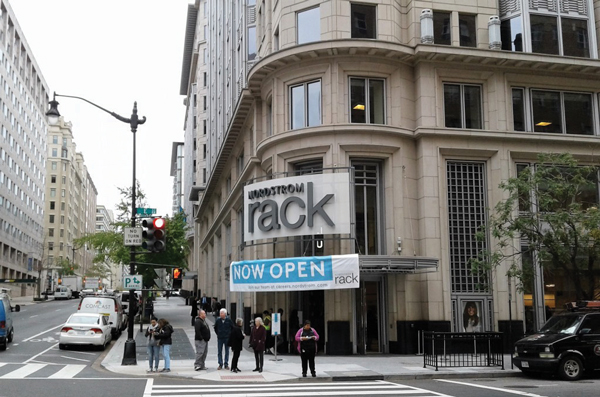Trending
High streets looking low in 2017
Stagnating rents and increasing vacancy rates are spurring concern on the nation’s most trafficked retail strips, which are also seeing new competitors

Ralph Lauren is packing up its Polo store on Manhattan’s Fifth Avenue. In San Francisco’s Union Square, Saks Fifth Avenue is consolidating and Macy’s will shutter its men’s store after selling the building to Morgan Stanley for $250 million. Macy’s is also looking to unload its Miami Beach flagship store on Lincoln Road as part of its plan to close 100 stores.
Across the country, the most trafficked high streets in the U.S. are feeling the pinch. The growth of e-commerce has traditional retailers rethinking their brick-and-mortar strategies, leading to an uptick in vacancy rates on the most expensive retail strips as record rent growth along many high streets recedes.
This year “will be fairly flat,” Gene Spiegelman, Cushman & Wakefield’s vice chairman and head of retail service, told The Real Deal. “But given the volatility in the retail world, a flat outcome is good. I believe landlords will be more cautious.”
Rents on eight of the top 10 U.S. retail strips — defined by their average rents per square foot — have taken a dive or remained stagnant, according to Cushman’s 2016/2017 Main Streets Across the World report. Moreover, Americans earning at least $150,000 annually said they planned on spending roughly just $16,000 on luxury goods this year — a 20 percent decline compared to 2016, according to a recent report from the Luxury Institute.
On the other hand, about 54 percent of those same high-wage earners said they would prefer making major purchases in actual stores.
Spencer Levy, CBRE’s head of research in the Americas, said high streets had a great run but are clearly experiencing a slowdown. The top strips still have an advantage, however, as they are known to attract consumers. “There are some pockets of softness,” Levy said. “But while we are going through a rough patch, I am overall positive about luxury retail.”
Using interviews, data in the Cushman Main Streets report and additional research, The Real Deal has broken down conditions on the top 10 retail strips — and what to expect in 2017. The rent noted is for all of 2016, and vacancy rates are for the first quarter of 2017.
1. Upper Fifth Avenue, New York City
Average monthly rent per square foot: $3,123, down 13 percent compared to 2015
Vacancy rate: 17.4 percent
Notable deal: In late November, Nike leased a 60,000-square-foot space at 650 Fifth Avenue for an estimated $35 million annually in rent.
Outlook: With a double-digit (and climbing) vacancy rate and with Ralph Lauren’s Polo store at 711 Fifth Avenue closing, many fear the country’s most expensive strip is due for a serious market correction. “Retail real estate in New York City as a whole is peaking,” James Cook of Jones Lang LaSalle said. Expect to see more landlords offering deeper concessions, like paying for the build-out of a tenant’s space, which can cost up to $1,000 per square foot.
2. Rodeo Drive, Beverly Hills
Average monthly rent per square foot: $800, no change compared to 2015
Vacancy rate: 3 percent
Notable deal: This past August, LVMH Moët Hennessy Louis Vuitton paid $122 million for a storefront at 420 North Rodeo Drive that houses the company’s Bijan brand. The $19,405 paid per square foot set a California record.
Outlook: The LVMH deal and Chanel’s $152 million purchase of its store at 400 North Rodeo Drive shows high-end global retailers are firmly planted in the nation’s second most expensive street, Newmark Grubb Knight Frank’s Executive Vice President Jay Luchs said. Strong rents coupled with low vacancies, high-income demographics and tourist activity will continue to propel a bullish market on Rodeo Drive.

An overview of Union Square
3. Union Square, San Francisco
Average monthly rent per square foot: $700, a 5.5 percent increase compared to 2015
Vacancy rate: 4.4 percent
Notable deal: Last September, an 11-story retail and office tower, home to Tiffany & Company at 360 Post Street, sold for $135 million ($1,365 per square foot).
Outlook: San Francisco’s most prestigious strip is in for some heavy blows as Macy’s and Saks Fifth Avenue both close their men’s stores there. Occupancy gains in Union Square will be largely offset by the shop closures, and vacancy rates will climb in 2017. The street is also facing more competition from the city’s Mid-Market district, where rents are cheaper. Still, the purchase of the Tiffany building and the opening of an Apple Store across the street continue to fuel investor demand.
4. North Michigan Avenue, Chicago
Average monthly rent per square foot: $550, a 4.7 percent increase compared to 2015
Vacancy rate: 3.2 percent
Notable deal: In January, Chicago-based shopping mall investor GGP (formerly General Growth Properties) paid $140 million for a building at 605 North Michigan Avenue.
Outlook: The Magnificent Mile’s single-digit vacancy rates are in jeopardy. Pending moves by high-profile tenants such as Apple, Crate & Barrel and Tourbillon, coupled with new developments, will add a lot more retail space in the coming year. While the vacancy rate currently sits around 3 percent, about 12 percent of retail space is actually available when one factors in subleases and lease expirations, said Greg Kirsch, an executive managing director in the Chicago office of Newmark Grubb Knight Frank.
5. Lincoln Road, Miami Beach
Average monthly rent per square foot: $325, no change compared to 2015
Vacancy rate: 8 percent
Notable deal: In February of last year, the Aldo Group paid $35 million, or $6,560 a square foot, for a 1930s building at 635-639 Lincoln Road.
Outlook: Despite continuing its run of eight- and nine-figure deals, Lincoln Road has hit a ceiling, local brokers and landlords believe. New tenants such as Nike are simply replacing ones that have left, like Williams-Sonoma. Meanwhile, rents have begun to dip under $300 a square foot in some buildings, said Tony Arellano, executive vice president of Miami-based Metro 1 Commercial Real Estate. “This lull is going to help reset Lincoln Road,” he added.

Penn Quarter’s Nordstrom
Rack
6. Penn Quarter, Washington, D.C.
Average monthly rent per square foot: $205, down 6 percent compared to 2015
Vacancy rate: 5 percent
Notable deal: In April of last year, discount luxury store Saks Off Fifth leased almost 34,000 square feet in a building that MetLife and Norges Bank bought for $505 million in 2014. Lease terms were not disclosed for the property at 555 12th Street NW.
Outlook: The opening of Saks Off Fifth, along with Nordstrom Rack in the same building, was key in the vacancy rate dropping by more than 40 percent last year in the East End, an area of D.C. that includes Penn Quarter, according to a 2016 report by boutique brokerage Dochter & Alexander. Before the two retailers signed leases for more than 73,000 square feet last spring, the vacancy rate hovered just above 10 percent.
7. Worth Avenue, Palm Beach
Average monthly rent per square foot: $150, no change compared to 2015
Vacancy rate: 3.3 percent
Notable deal: In March, an affiliate of the Amirsaleh Family Trust paid $19.5 million for the Via Bice retail complex, about $1,000 a square foot. The property leases roughly 16,700 square feet to restaurant Bice and boutiques for about $828,000 in rent a year.
Outlook: The Rodeo Drive of Florida lost one of its signature tenants when Hermès announced it was leaving its 3,444-square-foot store at 240 Worth Avenue. Yet Palm Beach retail experts claim the strip remains attractive, pointing to investor interest in properties like a Tiffany & Company-occupied building on the market that should fetch more than $40 million, or about $2,400 a square foot, said listing broker Robert Granda.
8. Newbury Street, Boston
Average monthly rent per square foot: $150, no change compared to 2015
Vacancy rate: 2.9 percent
Notable deal: Amsterdam-based men’s clothing store Suitsupply leased 10,000 square feet at 240A Newbury Street and is slated to open in July.
Outlook: Boston’s Back Bay submarket, where Newbury Street is located, continues to attract global retailers, luxury brands and restaurants, according to CBRE’s 2017 New England forecast. But vacancies along Newbury rose slightly in 2016 as asking rents for premium space reached historical highs — more than $300 a square foot. CBRE also cautioned that the pool of prospective tenants has diminished. The firm predicts rents tumbling in 2017 as retailers become less aggressive and more cautious about cost.

Stores on Walnut Street
9. Walnut Street, Philadelphia
Average monthly rent per square foot: $205, down 6 percent compared to 2015
Vacancy rate: 7.2 percent
Top deal: Last July, PH Retail, a Philadelphia commercial real estate investment firm, paid more than $50 million for a 30,000-square-foot space at 1501-05 Walnut Street and another property on Chestnut Street, the city’s other prime retail corridor.
Outlook: Despite a dip in rents, Walnut Street continues to attract retailers. In January, hip eyewear maker Warby Parker joined online men’s clothing retailer Bonobos and sports apparel company Under Armour there. PH Retail pushed for the Walnut Street and Chestnut Street acquisitions because of rising demand for high street retail, according to Randy Hope, co-founder and managing director of the firm.
10. Del Mar Heights Boulevard, San Diego
Average monthly rent per square foot: $78, no change compared to 2015
Vacancy rate: 4.8 percent
Notable deal: Jimbo’s grocery store signed a lease in March for 25,000 square feet of new space in Del Mar Highlands Town Center.
Outlook: This street benefits from being home to the Del Mar Highlands Town Center, a massive shopping mall that pushes the vacancy rate down into the low single digits, according to Phil Lyons, managing director of Cushman & Wakefield’s San Diego office. “Occupancy is near 100 percent, and shop rents are pushing over $100 per square foot,” Lyons said. Town Center owner Donahue Schriber Realty Group has also begun the next phase of the mall’s expansion, which includes 120,000 square feet of retail space.




